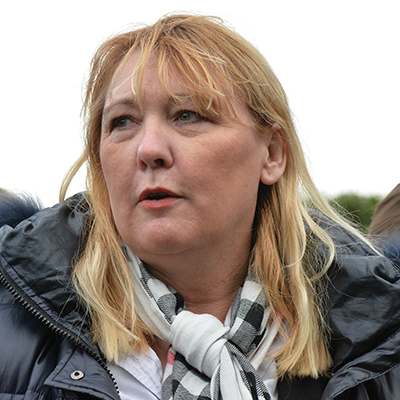 Story by Christopher Hector & Photos by Roslyn Neave
Story by Christopher Hector & Photos by Roslyn Neave
It is almost twenty years since we last visited the famous stud of the family Nijhof. There have been many changes, new houses, new stable barns, new working arenas, but the warmth of Jeannette Nijhof’s welcome remains the same. Actually she is Jeannette Benedict-Nijhof now, and she is assisted in her reception of our KWPN visitors’ group by her daughter Camilla and nephew Cameron.
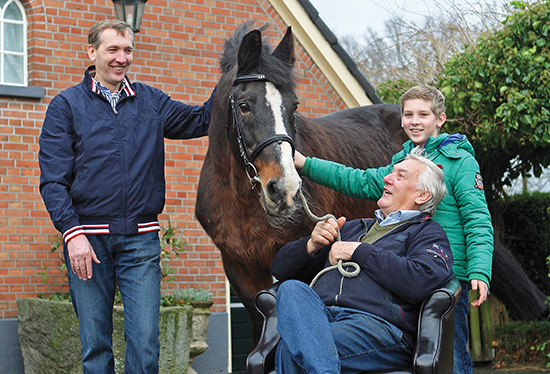
Three generations: Henk Nijhof Snr, Henk Jnr, and Cameron with the great Concorde
The stud was established by Jeanette’s father, Henk back in 1965. A back injury prevented Henk Senior taking over his father’s dairy farm, and the idea of working with horses was born. Henk Nijhof is well-known for his ability to ‘spot’ a stallion, and his buying trips, often with Dutch vet and fellow stud-master, Jan Greve, are legendary. They were the pair who spotted Voltaire’s value when no one else was interested in the horse, and the stallion ‘kick started’ the Nijhof operation.
Ever since then, the family has concentrated on stallions for the long haul, as Jeannette explains:
“We like to stand stallions that can perform at a high level – at Grand Prix level – and stallions that pass those abilities on to their babies. We are always trying to get our stallions to Grand Prix level, sometimes it is not possible because of an injury, but we are quite strict that performance is very high. We would like to have stallions that grow up here, and die here.”
“We don’t want fashionable stallions that have 600 breedings in two years, then out of the catalogue and next one… We want our stallions to stay for many years so that we have a very nice group of foundation sires.”
“After our first group of stallions, Voltaire, Burggraaf, Calvados, Cocktail and Concorde, we now have Clinton, Lord Z, and Heartbreaker, that are still here. We also have the group in the middle – Verdi, Quality Time, Spartacus, Eldorado van de Zeshoek and Johnson – that are performing at Grand Prix level now. Add to that some very nice young stallions, I’m Special de Muze, Elton John, Starpower, Elvaro, and some very nice coming stars like Latour, Grandorado TN, Talmann Tn and Maestro vd Bisschop.”
Approved the licensing this year, by Mr Blue / Hors la Loi / Libero, out of Numero Uno’s mother line
“We had a very good show at the KWPN licensing this year, we had two exceptional three-year-olds that were approved to add to our future. One by Eldorado out of a Chellano / Darco mare, the other, Mr Blue / Hors la Loi / Libero, out of Numero Uno’s mother line. Every year we try to add some new blood to our base.”
The Nijhof operation is one of Europe’s largest with over 600 horses on the property and others ‘stored’ on farms around Holland, but for Jeannette it is important to breed that number of foals to be able to assess their new stallions:
“Every year we buy or breed around 150 foals. That way, from the new stallions, we always have a lot of information. By the time their foals are two years old, we know, are they sound? Do they jump well? When the stallion is five or six, you already have very good information on him as a sire. Are they giving their good qualities to their children, or not? It is very good for us to have many foals from the young stallions’ first years. Also from the x-rays – if you have ten offspring from the stallion, and eight have OCD, it is no use to bother the breeders with this stallion any more…”
“It is important to have this information quickly – we get it even more quickly than the studbook. It’s our business, our livelihood, when we promote a stallion, we must know it’s good. We can only do well if the stallions have good progeny, if we have no-good horses, then we are out of business very quickly.”
“We have a lot of youngsters. Around 85% are offspring from our own stallions, and ten or fifteen percent are bloodlines we buy to have something new – Holstein, Belgian Warmblood, Hanoverian, wherever there is a good horse we will try and find it. The horses arrive here when they are six months old, they are weaned, then they get their shots, then we put them to our other farm, eight miles from here, and that’s where all the youngsters stay. Foals have a lot of diseases and infections, so they stay there in summer. In the fall they come here and we start free jumping them so we can make a selection for the New Year.”
It was off to the stallion barn, and the first stallion we saw was Tadmus, born in 2000, by Calvados out of a Concorde mare.
“He started breeding and had 25 mares and out of these mares, there are probably 15 Grand Prix horses. He is very high on the breeding values index, just after Heartbreaker and Padinus. He is number three, but he breeds very few mares and for a stallion, it is important that he produces a lot of foals.”
Coincidently, the weekend we were in Holland, ‘Doda’ de Miranda and AD Amigo B were winning a 1.45 speed class on the Florida circuit. Amigo is by Tadmus, out of a Heartbreaker mare – in fact, his pedigree is more-or-less a history of the Nijhof stud. Tadmus is by their imported Selle Français stallion, Calvados (Sable Rose), out of a mare by Concorde by Voltaire plus Amigo is out of a Heartbreaker mare – if they had just added Burggraaf in there somewhere, we’d have a full hand!
Heartbreaker meets the visitors
Just a few stables down we are introduced to the grand old man of the stud, Heartbreaker, who at 26 is no longer fertile but all is not lost, as Jeannette explains:
“In Italy they have a process called “ixci” – invitro fertilization.It is still quite expensive but we hope it will become less expensive in the coming years and therefore we have kept one thousand straws of Heartbreaker. Then we’ll have the chance of producing offspring by the real ‘one’. The other option is cloning but I don’t know if we will have to make that choice, but we have secured his skin to make the clone if we want to.
“Hopefully for the future we will have many more Heartbreakers. At the moment, in the WBFSH top 100 world rankings there are many direct offspring of Heartbreaker and 21 have mothers by Heartbreaker so he is very influential on the sire side, but also on the dam sires’ side.”
Next to Heartbreaker was an equally famous stallion, Clinton – between them they created the current hot sire in Germany, Cornet Obolensky, by Clinton out of a Heartbreaker mare.
CLINTON
“He still has semen that works. Last year it was pretty good, especially here at the stud. He is very popular because Cornet Obolensky is going so well, and this combination of him, with Heartbreaker blood, is great.”
Both are long-term residents: “Heartbreaker has been here since he was four-months old, and Clinton has been here since he was a-year-and-half old. They have been out to competitions with their riders, but they have been in our possession for a very long time.”
But not all the residents are as predictable, in the next stall, was a handsome, and well traveled chestnut, Guidam Sohn. Sold to Czechoslovakia where he competed in young horse classes, the stallion returned to Holland to Jos Lansink who competed him on the international youngster tour before the horse was injured. He is interestingly bred since he combines two great sires, Guidam and Zeus, neither of whom has produced stallion sons yet.
“He is a very big stallion, and we saw a lot of good offspring from him in the Czech Republic. He brings some new blood for the future. From Guidam, I think in Ireland there is only Luidam, but very little left of the line, although he produced a lot of Grand Prix jumpers.”
MARIUS CLAUDIUS
“Marius Claudius competed Grand Prix with Robert Whitaker for seven years, he won many World Cups, many Grand Prix. He is a little bit old fashioned so you have to use a modern mare. If you have a small blood type mare, that is good. He passes on the ‘Voltaire’ looks.”
“Here is Zambesi, a son of Heartbreaker who resembles his father very very much, you can see Heartbreaker in him, he is the most similar in type, the same conformation, the same way of over-jumping. He had a tendon pulled from the bone, a terrible injury. His four and five year old offspring are jumping very well, they are better in jumping under saddle than free jumping. In the past we had the same problem a little bit with Voltaire and Concorde, free jumping them, they would go fast and quick, and you thought uh oh… but they got better under saddle. On the other side, with a big stallion like Spartacus and his offspring, they are like the offspring of Calvados and Mr Blue, they jump a little slow, and you think uh oh, but they get much better under saddle, and they still have enough blood.”
Although you guess that jumping is the true beating heart of the Nijhof operation, dressage is a large and growing market in Holland, so of course, there is Sandro Hit to be found…
“Here is Spielberg, he is a dressage stallion and he is very pretty, very healthy, the only thing if you want to say something negative about him, his hind leg is not really strong, that is Sunny Boy / Sandro Hit, but he crosses really well with Jazz blood, because Jazz is a little bit hot, a little bit spooky, and he narrows that down. He doesn’t give chestnuts so you get a nice colour. We have now seen several very good offspring from Spielberg from Jazz lines.”
SPIELBERG
“He is a little bit Sandro Hit in the back leg, you need to have a Jazz mare, or a mare with a good hind leg, but other than that, he gives everything – prettiness, a nice colour. He doesn’t have the red factor so you will never get a chestnut, for some people that is very important, for me it doesn’t matter. He was competing up to Intermediaire I level but you can see he has a big fetlock, he had an accident, he caught his leg between some bars, but it is coming okay.”
Jeannette is not just being hopeful when she says ‘no chestnut’, quite a few of her stallions are marketed ‘no carrier of chestnut factor.’ “For us it is not important but some of the breeders find it very important that they have no chestnut foals, because it makes them easier to sell. It is easy to test by a DNA test, one test and we can share this information with the breeders… However, a good horse does not have a colour, it has quality.”
Another jumping stallion, Talmann (by Toulon), underlines the way the path to being a sire can take several directions in Holland: “As you can see, he is 17 hands, very tall. We are a family for performance, so we kept him back to let him grow and mature. Now he jumps very well under the saddle, and he will probably be presented for licensing as a four-year-old or four-and-a-half. If you send a horse like this to the performance test for three-year-olds, they return it immediately, they are too immature for the performance test. That is the good thing about the KWPN, that you have the chance to show your stallion many ways.”
So even though the youngster has yet to do his performance test, he already has his chance to prove what he can do as a sire:
“He bred about 50 mares last year, because he has a very nice pedigree, and he is very good looking. We’ll have his foals this year and then we will try and get him approved under saddle. With the KWPN it is very nice, you can present them as a three year old, but if you think it is too early, you can come as a four-year-old, or with a good performance in the stallion competitions. You can always come back, even as a Grand Prix stallion.”
“When I was little, the Stallion Show was the most important event of the year, it still is, but then you depended on it for the rest of the year, if a stallion was approved or not – or then you had to wait a very long time. Now, okay, if your stallion is not approved, they have seen it, and next year if you have a nice performance as a four or five-year-old – you must be in the best 10% of your age group – but you always have the chance to come back and prove your stallion is good. If you are convinced that you have a good horse, it is worthwhile keeping him. Sometimes for three-year-olds it is very hard, the big ones are sent out of the performance test because it is too difficult for them, it doesn’t mean it’s not a good horse; it is just too early.”
JOHNSON
“Johnson is a little bit the opposite of Florencio – you can use him over a bit of a blood mare. He is quite big with quite a lot of presence himself, I would use him over a smaller blood mare.”
Unlike a lot of fashionable young Dutch stallions who tried to go Grand Prix and didn’t make it, Johnson is a real rarity, a licensing winner who went on to compete Grand Prix…
“It’s a problem with the three-year-olds, it is always difficult, you might have a nice horse, but you don’t know how they are going to go
under saddle.”
“We have a lot of stallions at home, but some are with their riders, Verdi is with Michael van der Vleuten, and Quality Time is with Jeroen Dubbeldam, Spartacus is with Henk van der Pol, Johnson is with Hans Peter Minderhoud and Eldorado van de Zeshoek with Willem Greve. We keep them here until six or seven-years-old, and then we try to find the best possible rider for them to go Grand Prix.”
Which are your most popular stallions?
“At the moment I think Verdi and Johnson. Johnson will be more popular after the Stallion Show now he has produced the KWPN-champion, and Verdi gets even more popular because he is now starting his seventh year of Grand Prix. He has done Olympics, World Equestrian Games, World Cup Finals, and the good thing is that he now has 80 offspring competing at international level.”
VERDI
“He makes very nice offspring, he imparts his qualities to his children. They are a little bit late growing like himself, they start to jump exceptionally well at five and six years old. In the mare test for three-year-olds, they don’t look so spectacular, but when they are really nice is when they are older. He goes well with mares that have blood. He looks quite a modern stallion, so you think you can use him on heavy mares, but they get too cold. You need a percentage of blood in the dam line and not too small, and a nice medium size, 165/170 cm, and a bit of blood, not a big bully mare.”
Is it hard to get the mare owners to use a young stallion?
“There was a time when all the Grand Prix stallions were fashionable, and the young stallions not at all, then a time when young stallions would get all the mares, and the older stallions, nothing at all – now it is a mix. Some breeders really like to use the younger stallions, and some really like the older proven stallions. Like I’m Special de Muze, or Latour, our Darco stallion, they are quite young but they easily breed 250 to 300 mares. It really depends on the pedigree, on the performance. Sometimes you have a young stallion that is very popular, but many breeders prefer to go for a proven sire first.”
Is it influenced by the breeding values?
“We were just discussing the breeding values, because we were very disappointed that Johnson and Verdi didn’t get their ‘keur’ predicate. Verdi did Olympics, he did World Games, four World Cup Finals, he jumps 1.60, compared to some other stallions that only jumped 1.40, and he has many offspring competing international, but he only has a breeding value of 134 and to be Keur, you must have 140 – but the breeding values are not calculated right. They need to look at this because the result is misleading. For example, I think Verdi and Johnson should have been awarded “keur” this year, it needs to be reviewed how it is calculated.”
“You must learn how to read these values. For example, Florencio is now “keur” but he had to do everything on his own because his father is Florestan and his mother is Weltmeyer, so he doesn’t get any values from his parents because they are not in Holland. It took him a long time to get the score, and people should understand how it works. The KWPN should review the system. They put up young stallions who have done nothing with an extremely high value, okay give them a high expectation, but not too high, the highest expectation must be for the stallions with a high reliability and with proven results. The system needs to be reviewed to make it more realistic.”
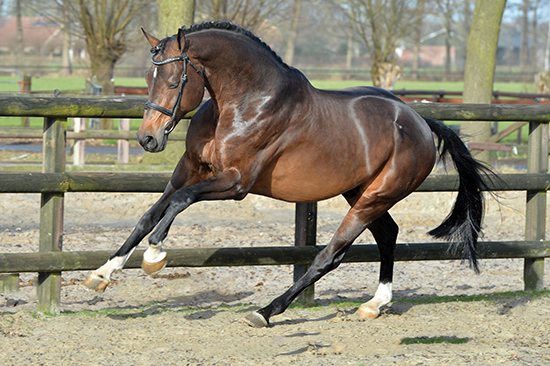
FLORENCIO
“Our new Keur stallion, Florencio crosses really well with the Johnson mares. They are a little bit taller, and he gives a lot of blood – although Florestan / Weltmeyer sounds old-fashioned, he’s a blood type stallion. He breeds well with the mares that lack blood, the cross with Johnson, or Ramiro, or any mares that are a little bit heavy, he will lighten it up again.”
The Nijhof operation is very much a partnership with their customers, even to the extent of using the Nijhof resident vet for their own breeding needs…
“We have our own vet employed here, he does all the palpation, scanning, embryo transfer, and in the winter, he does x-rays, small operations, he has a job all year round.”
“We have a relationship with our mare owners that has lasted many years, they come back all the time and we have had lots of foals from these breeders so we have a good knowledge of which are the good mares. The mare owners use our vet a lot of the time, to check the mare and to get her in foal and to check the pregnancy, it is cheaper than getting a vet to come to their place.”
CANABIS Z
“Canabis Z is a son of Contender. He is a Holsteiner stallion and he bred mares in his first year, and then competed for six or seven years. He has offspring that are Grand Prix jumpers, or two years old. There are a lot of his offspring doing well at Grand Prix level, then nothing, then some that are coming three.”
“He works with normal sized mares, he makes a lot of movement, he has a very strong character, you must pay a little bit of attention to the character of the mare, not one that is too difficult. He breeds very nice jumpers. The bloodline – Contender and Silvester – is a little heavy, so I think a little blood will help in the mare, a nice Voltaire or Heartbreaker, or something like that.”
“Our vet is also good with embryo transfer and can help synchronise with the recipient mare. There are a couple of farms where they have many recipient mares – we can ring them and say, we have a mare inseminated today, we will flush it in seven days, and they will have a mare ready. We flush the embryo and it goes in a box with certain material, and in the afternoon, it is implanted there. The good thing is that you have a recipient ready all the time – it works very well. They only charge you when the recipient mare is pregnant. Using those farms the cost works out at about €3000 more than a normal pregnancy. It is expensive, but if you have a very nice young sports mare and you want to get going quickly, it is a nice way of having more babies… or if you have a very old mare with a bad uterus, who loses her embryos, it is again a good idea. It is very interesting for the good mares, but there are a lot of extra costs, and for the average breeder, very expensive. For us, putting a young mare into the sport is not a problem we have our own rider, but for the farmer when you have to send your four-year-old mare to a rider and have to pay €700 a month, then in one year it has cost ten thousand more.”
“A lot of people want a foal out of a Grand Prix mare, but it is not always possible. It is very good with the KWPN, we have the mare performance test so at least you have some information, this is a very good tool to start with.”
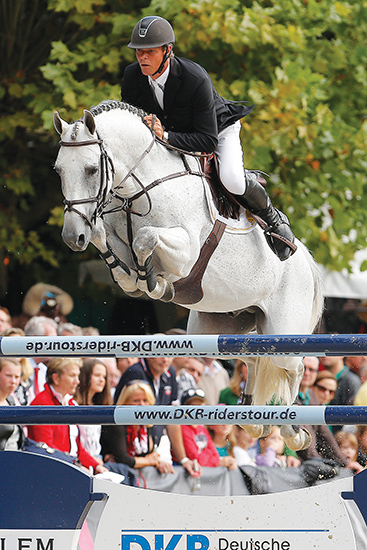 QUALITY TIME
QUALITY TIME
“Quality Time, he really breeds a lot of blood. My father used to call Quality Time our Holsteiner Thoroughbred, he lightens up the horses. He jumps Grand Prix and he breeds horses that jump Grand Prix. You have to be a little bit careful with the neck, he is a little bit straight, but we see a lot of nice horses under saddle by him. Lots of blood…”
“We have our own x-ray machine, so we can send x-rays to customers. It means you have a very good record, if the horse has not a nice x-ray, but you can follow it for say some years, and say, okay, it is seven years old, it hasn’t changed a bit. You can give the history to a customer. That is even more important for dressage than jumping. A lot of dressage customers don’t want any chips in the fetlocks, or the hocks, they are very strict. We now have our own operation table so we can correct them when they are two-years-old – of course we have to tell you that the horse was operated on, but after a year you can sell him as a sport horse. Not as a breeding stallion, because for a breeding stallion you cannot do that, it is also very inheritable, you have it a lot from the same mares, it comes back.”
“In April we make our stallion presentation. We try to make a stallion show with a lot of information, with mares and foals, we try to advise the breeders on which stallion is best with which type of mare, what is the best combination – breeders get a lot of advice. At the moment there are a lot of stallion shows that are very spectacular, music and lights, but no information. It is all too nice and too good. I think it is important to share what we know with the breeders, don’t do this, or do that, so we can help each other. It is not in our interest to have a fashionable stallion to breed as many mares as possible – we want our stallions for many years, good stallions, and you never know, sometimes you have great expectations and then it is a little bit disappointing, but often the ones that we have do very nicely and prove themselves in the competition arena.”
ELDORADO VAN DE ZESHOEK
“It’s a nice example of Clinton and Heartbreaker, he is Clinton and Toulon, by Heartbreaker. He is a big horse, a lot of scope, he breeds very nice with mares with some blood. Last year he had two top sons at the performance test, so he is starting to produce very nice jumping horses. He adds I think in the index, three centimetres in size, so if you have a small mare he will easily add height. Also no chestnut factor, no chestnuts by him, the same for Verdi.”
Which mares for him? “A little bit blood mares. Smaller because he is quite big and a little bit on the heavier side. He is the opposite to Quality Time.”
Semen from the Nijhof stallions travels Europe and the world…
“We can send out semen very quickly. You call today, and it is there tomorrow morning. It is very easy. In Germany they deliver at night so early they have the semen. Okay for the rest of the world, we send Frozen semen. In the United States, New Zealand and South Africa, we have a tank, store the semen, and we sell it ourselves, then if there is a problem, if someone has a dead foal or something like that, we handle it immediately. It works very well. We mostly do a live foal guarantee. If the foal is not born alive, you can come back the next year. We are very flexible, we like happy customers, if you try Clinton two times, and you are not successful, you can easily change to one of the other stallions, and in the end you pay the fee for the stallion your mare is in foal to.”
“With the frozen semen, if you have had two tries and the mare is not pregnant it is always good to then change stallions. We have had the experience with frozen semen, that the mare catches on the first or second time, if they do not catch in two times, either the semen is no good or the mare is no good, or the combination is no good. You sometimes have mares that you take a stallion two or three times, and it doesn’t work, you try another stallion and it works. It’s too expensive to keep trying with frozen semen.”
“Right now the market is not so great but hopefully it is coming better. The breedings have dropped quite a bit in Europe – in France, in Germany, everywhere – but now more people are coming to look for young horses. In 2009 it was still a big year for breeding, and there are many five/six year olds, after that the breedings went down, and so there is a lot of demand for three and four year olds, it’s picking up very quickly and we have many customers again for young horses at the moment.”
STARPOWER
“Starpower – a son of Stakkato / Escudo, from Hanover. We have two stallions with Stakkato blood, the other is Spartakus who jumped really well on Thursday night. We have just had the first few Starpower yearlings at the KWPN x-ray inspection, all very healthy.”
It’s twenty years since I interviewed you last – is the passion to breed horses still as strong?
“Even stronger, if you have the passion for breeding and horses, it always stays. For us it is great that my daughter and my nephew, are also interested, we hope to pass it on to our children, like we hope our stallions pass it on to their offspring. We are still very passionate to breed the best possible horse for dressage and jumping, and to do that for many more years. My father is a very proud grand-dad… and we are proud parents.”
You’ve bred well…
“We hope so!”
“I’m Special is one of our new stars, like Heartbreaker was when you visited. At six, seven years old, he is in the same category. A very nice jumper, very careful, we have a lot of expectations for him. He is approved in Belgium, bred by Joris Brabander, and we bought him when he was three years old. The father and the mother both jumped Grand Prix, that’s what performance breeding is all about. He is black, that is also fashionable. We have had a lot of mares for him over the past two years. His oldest here are one-and-a-half coming two, so we hope to see them free jumping soon.”
Jeannette’s brother, Henk Junior, wanted time to see how his crop of I’m Specials jumped: “The oldest are coming three, but they are in Belgium. Next week we have eight or nine of ours that are two-years-old, and we will start free jumping them and we should know more. In type, they are blood, pretty big, because he himself is normal size, they are a good size. A bit downhill, so I think he must have a mare with a good front – he’s a bit like Verdi or Concorde, a bit downhill.”
What sort of mares? “I think he is in the middle. A stallion like Heartbreaker or Quality Time, must have big strong mares, a stallion like Eldorado or Spartakus, they need smaller mares with some blood – I’m Special is in the middle. Maybe not too heavy mares, and maybe not too small, not the 10% biggest or smallest, in the middle, but ask me in a couple of weeks when I have seen the youngsters jumping, then I will know more.”
And the verdict? “The offspring of I’m Special de Muze were all tall and jumped with a lot of scope and suppleness. We are excited!!”
This article originally appeared in the THM July 2015 issue.
Looking for leading European bloodlines in Australia? Like Floriscount combining Florencio and Donnerhall… Go to www.ihb.com.au
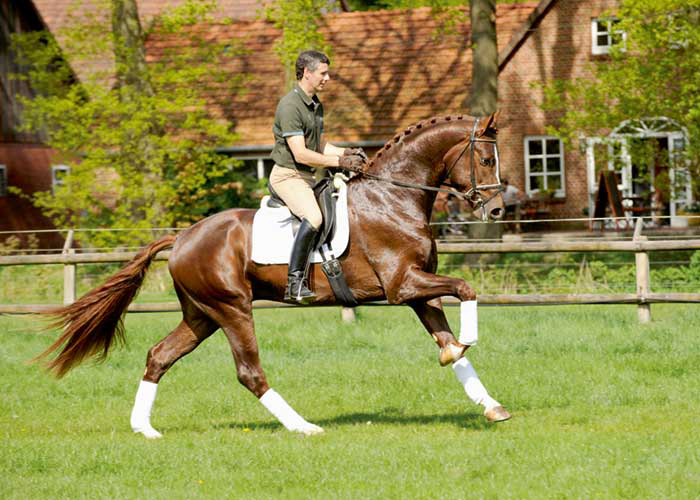



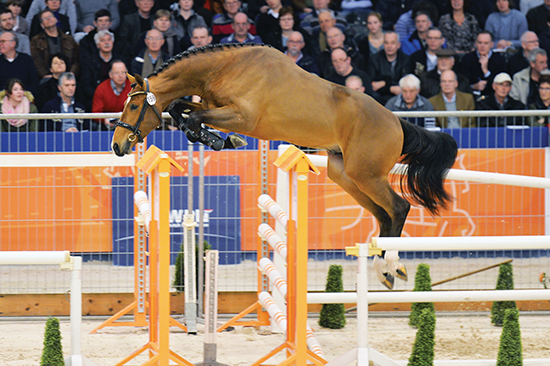
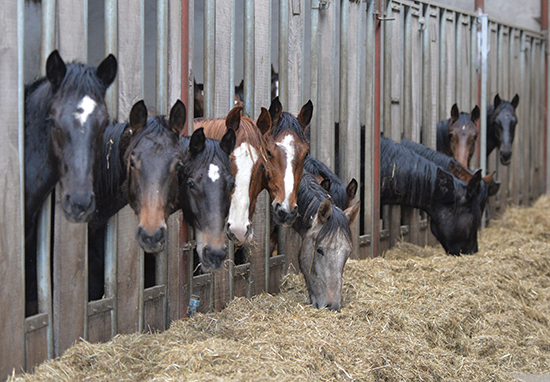
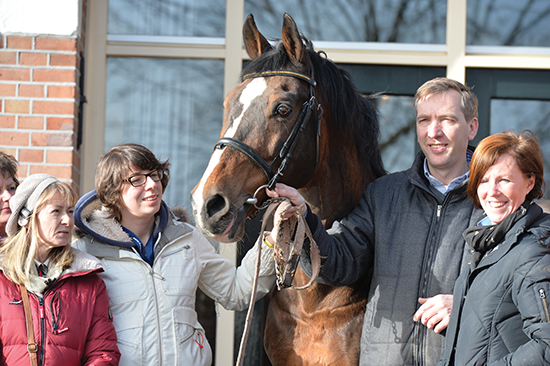
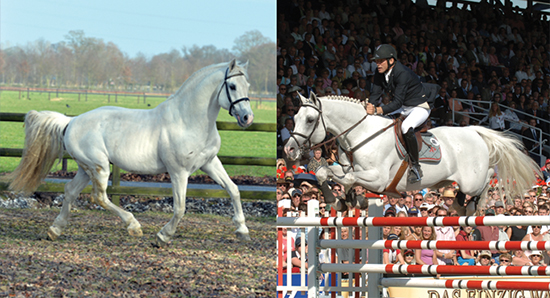
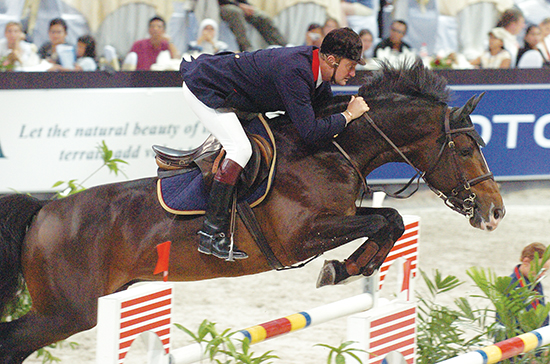
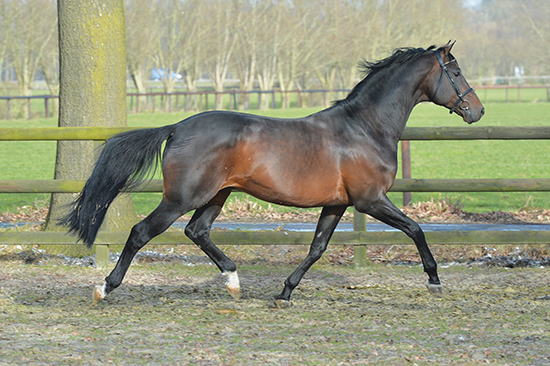
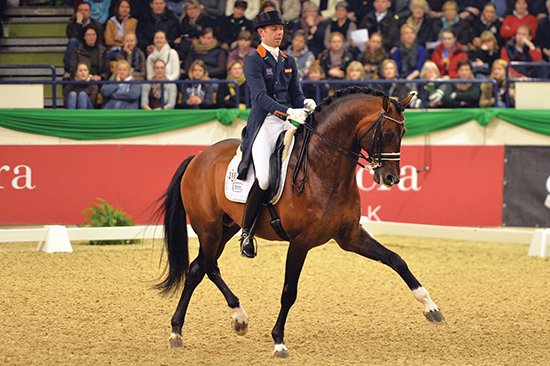
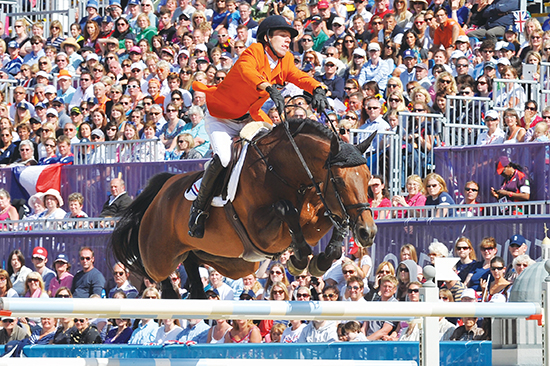
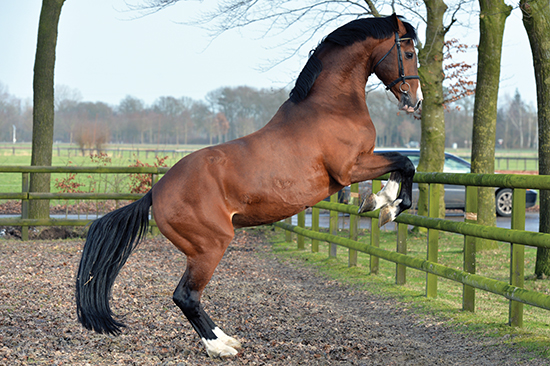
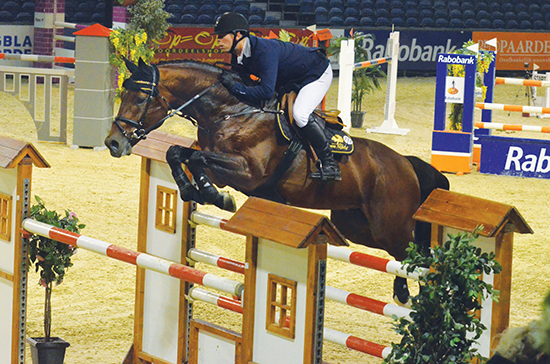
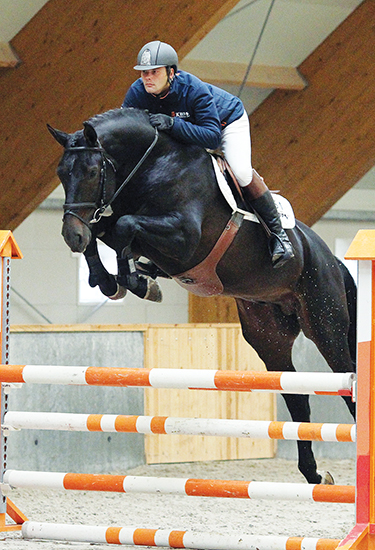
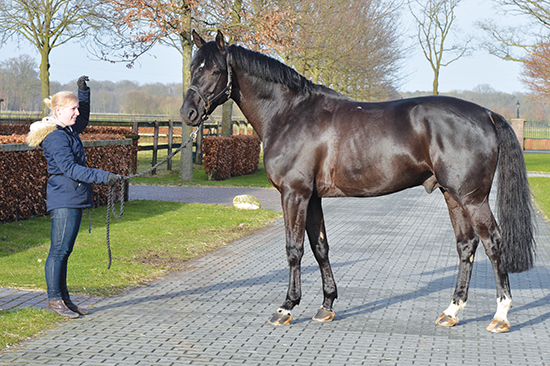
Thanks. I just found out my holstiner mare is in foal to Quality Time on the first try! She has a foal at her side by VDL Dakota .
We have a 6yr old by quality time won and placed in 5yr old classes, competed by 16yr old girl. Very promising for 6yr old classes, huge jump. I’ve owned lots of horses and she has the kindest temperament of any, loves attention and follows you around like a dog!
Hi to all
what type of mare conformation wise is best suited to cross with cornet obolensky
thanking you